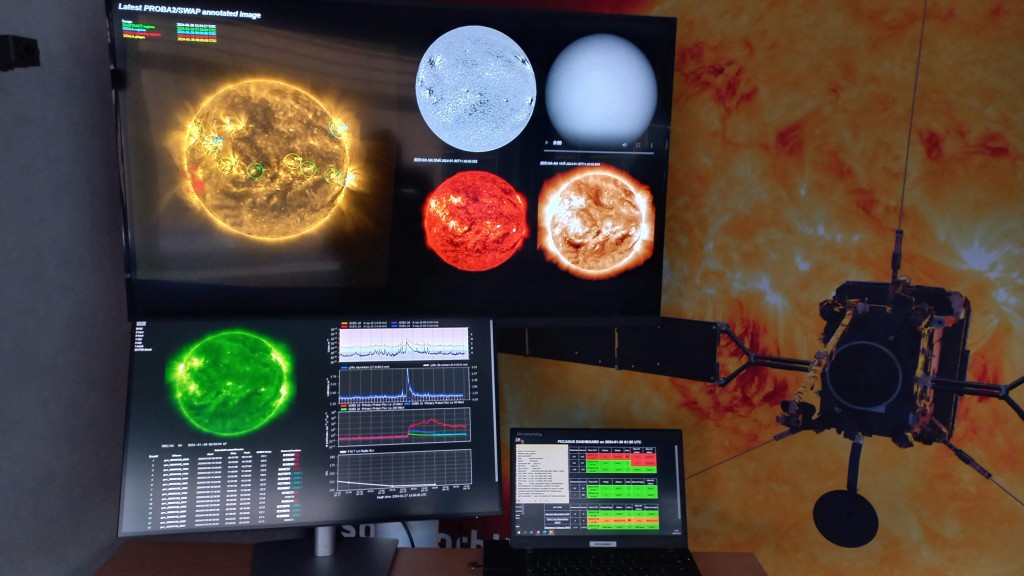Strong solar eruption directed to Earth – chances for Aurora in Belgium
By the STCE, the Belgian space weather institute
On October 9, 03:56 Belgian time, the Sun released an extreme solar flare of category X. This is an intense light flash. We define 5 categories: A,B,C,M and X. An X-flare is 10000 (!) times stronger than an A-flare. A solar flare has an immediate impact on radio communication on the day side of the earth as radio waves are attenuated. It can even occur that radio communication is completely impossible.
The solar flare was also accompanied by a shower of energetic particles that entered the atmosphere at the Earth’s poles and, like the flash of light, made radio communication difficult. These particles also added noise to the observations of a telescope aboard the Solar Orbiter satellite.
Along with the flash of light, a solar cloud escaped, which we observed shortly thereafter in images of the solar atmosphere. A plasma cloud consists of an extremely hot gas that is electrically charged and carries a magnetic field.
The active area where the light flash occurred and the cloud escaped was in the center of the solar disk, on the Sun-Earth line. Therefore we know that this cloud is coming straight toward Earth. The clouds that escaped from the Sun over the past few days have cleared the path to Earth, making it easier for this cloud to move through space. As a result, the October 9 plasma cloud is faster than an average solar cloud: an estimated 1900 kilometers per second (that’s nearly 7 million kilometers per hour!). An average solar cloud takes several days to travel the distance between the Sun and the Earth. Very fast plasma clouds, like this one from October 9, race to Earth in less than a day.
When the cloud’s magnetic field has a certain orientation, it can easily shake and even break up the magnetic field lines of the Earth. This causes charged particles in the Earth’s environment to be launched at high speeds toward the poles, where they collide with atoms in the Earth’s atmosphere and create auroras in an oval around the Earth’s poles. In this way, auroras result from a geomagnetic storm. Only when the cloud passes the 2 satellites that are right in front of Earth, will we know the orientation of the cloud’s magnetic field. Until then, we can only guess.
Aurora is visible in Belgium with the naked eye when we face a magnetic storm of magnitude 9 on a scale between 0 and 9. When this is the case, there is a very good chance that the auroral oval will extend over Belgium. Auroras form at altitudes starting from 100 km and are only visible when it is sufficiently dark and the view is not obstructed by clouds.
Besides auroras, there are also adverse effects associated with a magnetic storm on Earth. Radio communication at the poles becomes difficult or even impossible, and errors can creep into satellite positioning.
Space weather forecast by the STCE
Since the solar flare occurred, alarm bells have been ringing at the STCE space weather office. The STCE is closely monitoring the situation and estimating the magnitude of the magnetic storm. According to the STCE, a magnetic storm of strength 7 to 9 is possible. The STCE has also issued a warning with an estimated arrival time of the cloud on Thursday, October 10 in the afternoon (local time). So in case of clear skies, it is definitely worth taking a look at the northern sky during the night of October 10-11. Follow the progress of the space storm on the STCE website: https://www.stce.be/
Newsflash with observations of the storm – English/Scientific: https://www.stce.be/news/728/welcome.html
Latest space weather bulletin, i.e. URSIgram – English/Scientific: https://www.sidc.be/spaceweatherservices/managed/services/archive/product/meu/latest
The STCE press release: https://www.stce.be/nl/Strong_solar_eruption_chances_for_aurora_in_Belgium

